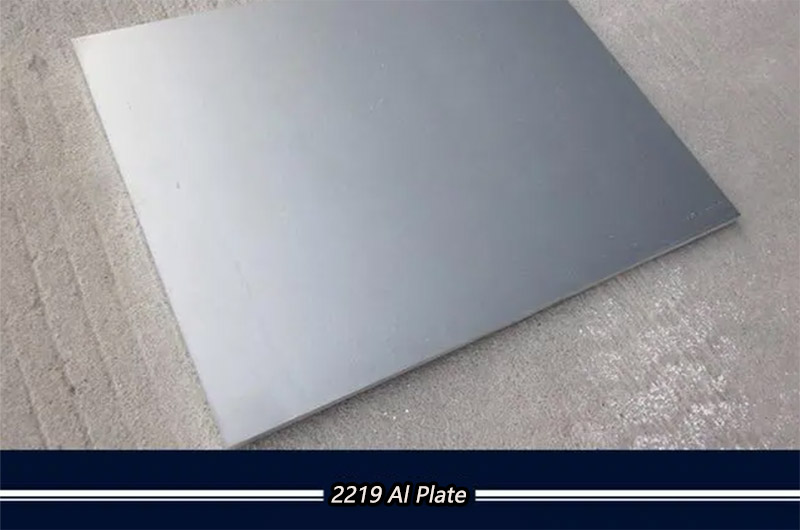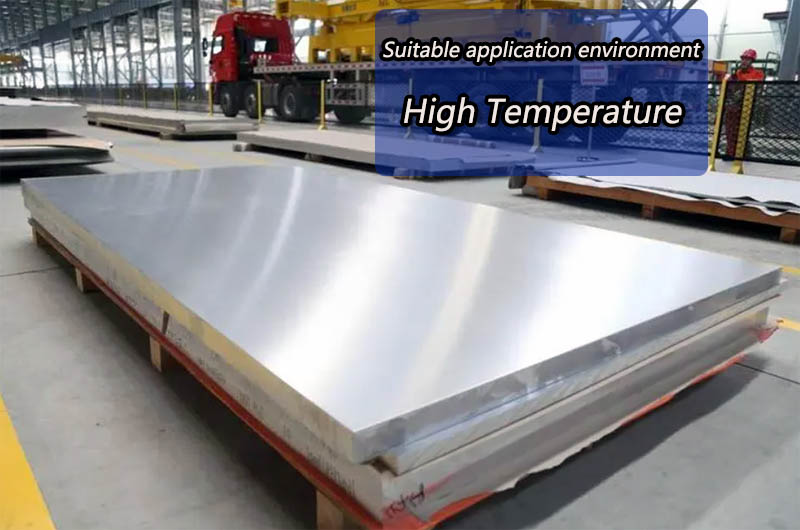2219 Aluminum Plate Sheet
Temper: T6/T851 Stable Performance
What is Aluminum Grades 2219?
The 2219 aluminum grade is an aluminum-copper alloy that belongs to the 2xxx series of aluminum alloys. It is mainly composed of aluminum, with copper as the main alloying element. This alloy is known for its high strength and excellent corrosion resistance.
2219 aluminum alloy, American wrought aluminum, and aluminum alloy. 2219 aluminum alloy has poor corrosion resistance and good machinability; it has poor brazing properties and is easy to arc welding and spot welding. It is suitable for structural parts and high-strength welded parts working at a high temperature of 315℃.

2219 Aluminum has high strength and low ductility, and higher strength can be obtained after heat treatment.
To improve corrosion resistance, 2219 aluminum can be treated by covering commercial pure aluminum alloys (such as 1050) or coating. This alloy is usually formed by extrusion and forging, not suitable for the casting process.
When is the 2219 Aluminum Plate the Best Choice?
2219 aluminum plate is known for its high strength and excellent ability to withstand high temperature environments, making it a suitable choice for specific applications. The following is the scenario where the 2219 aluminum plate is the best choice:
1. Aerospace Applications
2219 aluminum is commonly used in the aerospace industry for structural components, particularly where high strength, durability, and high-temperature resistance are required. It is used to make aircraft fuselages, wings, and other critical components.
The best-selling aerospace aluminum plates are
- 2219 Aerospace Aluminum Plate
- 2024 Aerospace Aluminum Plate
- 7075 Aerospace Aluminum Plate
- 2618 Aerospace Aluminum Plate
- 2017 Aerospace Aluminum Plate
2. Low Temperature Environment
2219 aluminum has good properties at low temperatures, making it suitable for cryogenic applications. It maintains strength and toughness even in extremely cold conditions.
3. High Temperature Environment
2219 aluminum alloy has excellent high-temperature resistance and is ideal for applications exposed to high temperatures, such as aerospace propulsion systems, rocket engine components, and heat shields.
4. Weldability
2219 aluminum has good weldability, especially compared to some other high-strength aluminum alloys. It can be welded using a variety of methods, which is important for manufacturing complex aerospace structures.
5. Corrosion Resistance
While not as corrosion-resistant as other aluminum alloys like 6061 or 7075, 2219 aluminum still has reasonable corrosion resistance. It may be suitable for applications where corrosion is an issue but not a major factor.
6. High Stress Applications
Due to its high strength, 2219 aluminum is used in applications that are subject to high mechanical stress, such as load-bearing components in aerospace and high-performance engineering.
7. Non-magnetic
2219 Aluminum is non-magnetic, which is important for applications where magnetic interference is a concern, such as scientific instrumentation and some specialized equipment.
2219 aluminum is not typically used for general-purpose applications, and other aluminum alloys such as 6061 or 7075 may be more cost-effective and provide adequate strength. The choice of alloy depends on the specific requirements of the application, and 2219 aluminum is selected when its unique combination of properties is critical to meeting those requirements.

2219 Aluminum Plate Specifications
| Dimension | Common Range |
|---|---|
| Thickness | 0.5 mm (0.020 inches) to 100 mm (4 inches) or more |
| Width | 1000 mm (39 inches) to 2500 mm (98 inches) or more |
| Length | 2000 mm (79 inches) to 6000 mm (236 inches) or more |
2219 Aluminum Plate Typical Thickness
The specific thickness of the 2219 aluminum plate may vary depending on the application and manufacturer. However, common thickness ranges from 1.6 mm (0.063 in) to 50 mm (2 in) or more.
| Alloy | Thickness (mm) | Thickness (inches) |
|---|---|---|
| 2219 aluminum plate | 1.6 | 0.063 |
| 2219 aluminum plate | 3.2 | 0.125 |
| 2219 aluminum plate | 4.8 | 0.188 |
| 2219 aluminum plate | 6.4 | 0.25 |
| 2219 aluminum plate | 9.5 | 0.375 |
| 2219 aluminum plate | 12.7 | 0.5 |
| 2219 aluminum plate | 19.1 | 0.75 |
| 2219 aluminum plate | 25.4 | 1 |
| 2219 aluminum plate | 38.1 | 1.5 |
| 2219 aluminum plate | 50.8 | 2 |
Material Properties of 2219 Aluminum Plate
| Physical properties | |
|---|---|
| Density (ρ) | 2.84 g/cm3 |
| Mechanical properties | |
| Young's modulus (E) | 73.8 GPa (10, 700 ksi) |
| Tensile strength (σt) | 172–476 MPa (24.9–69.0 ksi) |
| Elongation (ε) at break | 3-14% |
| Poisson's ratio (ν) | 0.33 |
| Thermal properties | |
| Melting temperature (Tm) | 543 °C (1, 009 °F) |
| Thermal conductivity (k) | 116-170 W/m*K |
| Linear thermal expansion coefficient (α) | 2.25*10−5 K−1 |
| Specific heat capacity (c) | 864 J/kg*K |
| Electrical properties | |
| Volume resistivity (ρ) | 39-62 nOhm*m |
2219 Aluminum Plate Mechanical Properties (Typical)
| Mechanical Property | Typical Value |
|---|---|
| Ultimate Tensile Strength | 300 - 380 MPa |
| Yield Strength | 210 - 270 MPa |
| Elongation | 10% - 15% |
| Modulus of Elasticity | 73 GPa (10, 600 ksi) |
| Hardness (Brinell) | 70 HB |
Note: Specific mechanical properties such as tensile strength, yield strength, and elongation may vary depending on the specific manufacturing process and heat treatment used for the 2219 aluminum grade.

Equivalent to Aluminum 2219
- AA2219
- AlCu6Mn (European designation)
- 2.0918 (European designation)
- Al 2219
- UNS A92219
2219 Aluminum Plate Machinability
2219 aluminum has fairly good machinability but can be more challenging to machine than some other aluminum alloys. The presence of copper in the alloy composition provides strength but also leads to increased tool wear and heat buildup during machining.
2219 Aluminum Plate Chemical Composition (Weight Percentage)
| Element | Composition Range |
|---|---|
| Aluminum (Al) | 91.5% - 93.8% |
| Copper (Cu) | 5.8% - 6.8% |
| Iron (Fe) | 0.3% max |
| Magnesium (Mg) | 0.02% max |
| Manganese (Mn) | 0.2% - 0.4% |
| Silicon (Si) | 0.2% max |
| Titanium (Ti) | 0.02% - 0.10% |
| Vanadium (V) | 0.05% - 0.15% |
| Zinc (Zn) | 0.1% max |
| Zirconium (Zr) | 0.10% - 0.25% |
| Residuals | 0.15% max |
Typical 2219 Aluminum Plate
2219 t6 Aluminum Plate
- T6 is the state name indicating the heat treatment state of aluminum alloy.
- T6 state refers to solution heat treatment and artificial aging conditions.
- The T6 temper provides the highest strength and hardness of the 2219 aluminum alloys.
- 2219 t6 Aluminum has excellent mechanical properties including high tensile strength and good toughness.
- 2219 T6 aluminum sheet is commonly used in applications requiring high strength, such as aerospace structures and components.
2219 t851 Aluminum Plate
- T851 is another state designation for the 2219 aluminum sheet.
- The T851 state refers to solution heat treatment, stress relief, and artificial aging conditions.
- 2219 T851 The T851 temper offers improved stress corrosion performance and enhanced dimensional stability compared to the T6 temper.
- 2219 T851 Aluminum maintains high strength and hardness while minimizing the risk of stress corrosion cracking.
- 2219 T851 aluminum plate is commonly used in critical applications where maximum strength and stress corrosion resistance are required, such as the aerospace and defense industries.

It is worth noting that the "T6" and "T851" temper designations are specific to the heat treatment process and resulting properties of aluminum alloys. Aluminum sheet size, thickness, and other specifications may vary by application and supplier. It is recommended to consult the manufacturer or supplier for accurate information on the available 2219 aluminum sheet in these temper conditions.
What is Aluminum 2219 Used for?
2219 aluminum alloy is commonly used in a variety of industries and applications requiring high strength, good weldability, and corrosion resistance. Here are some common uses for 2219 aluminum:
- Aerospace industry: 2219 aluminum is widely used in the aerospace industry for structural components of aircraft and spacecraft. It is commonly used to make aircraft fuselage skins, wing structures, and rocket motor casings. Its high strength-to-weight ratio and good fatigue resistance make it suitable for aerospace applications.
- Defense industry: Due to its high strength and good weldability, 2219 aluminum has been applied in the field of defense. It is used to make military vehicles, armor plates, and missile components.
- Cryogenic applications: Aluminum 2219 has good mechanical properties and low-temperature resistance, making it suitable for low-temperature applications. It is used in the construction of cryogenic storage tanks for liquefied gases such as liquid nitrogen and liquid oxygen.
- Pressure Vessels: The combination of strength and corrosion resistance makes 2219 aluminum suitable for pressure vessel applications. It is used in the manufacture of high-pressure tanks for a variety of industrial uses, including gas storage and transportation.
- Marine Industry: The corrosion resistance of 2219 aluminum makes it suitable for marine applications. It is used in the construction of ships, ship superstructures, and other components exposed to the harsh marine environment.
- Welded Construction: 2219 Aluminum is known for its excellent weldability. Commonly used in welded structures that require high strength and good corrosion resistance, such as bridges, trusses, and other load-bearing structures.

These are just a few examples of the many applications for 2219 aluminum alloy. Its unique combination of properties makes it a versatile material for a variety of industries requiring a balance of strength, weldability, and corrosion resistance.
Welding 2219 Aluminum Alloy
Welding 2219 aluminum alloy requires special consideration due to its composition and properties. Here are some key points to know about welding 2219 aluminum:
- Welding Process: 2219 aluminum can be welded using a variety of processes, including gas tungsten arc welding (GTAW or TIG), gas metal arc welding (GMAW or MIG), and friction stir welding (FSW).
- Filler material: The commonly used filler material for welding 2219 aluminum is ER2219. This filler wire is specially designed to match the composition of the base metal and provide good strength and corrosion resistance in the welded joint.
- Preheating: Welding 2219 aluminum usually does not require preheating of the parent metal. However, preheating may be beneficial for thicker sections or in cold environments, helping to reduce the risk of cracking.
- Joint Design: Proper joint design is very important for successful welding. Joints shall be properly prepared and edges shall be clean and free from contamination such as oil, grease or oxides.
- Shielding gas: When using a TIG or MIG welding process, a shielding gas such as argon is often used to protect the weld pool from atmospheric contamination and oxidation.
- Post-Weld Heat Treatment: 2219 aluminum can benefit from post-weld heat treatment (PWHT) to relieve residual stress and improve the mechanical properties of the weld. This is especially important for critical applications where maximum strength is required.
- Welding Safety: As with any welding process, proper safety precautions must be followed, including wearing appropriate personal protective equipment (PPE) and ensuring proper ventilation to prevent exposure to fumes and gases produced during welding.
2219 Aluminum vs. 6061
Composition
- 2219 Aluminum: It is an aluminum-copper alloy with additional elements such as iron, manganese, silicon, zinc, and trace elements added.
- 6061 Aluminum: It is an aluminum-magnesium-silicon alloy with added elements such as chromium and zinc.
Strength
- 2219 Aluminum: It has higher strength than 6061 Aluminum, especially in T8 temper. It is commonly used in applications requiring high strength, such as aerospace structures.
- 6061 aluminum: moderate strength, known for its good combination of strength and workability. It is widely used in various structures and general purposes.
Weldability
- 2219 Aluminum: Compared to 6061 Aluminum, it is less weldable due to the presence of copper, which can cause hot cracks during welding. Successful soldering requires specific techniques and considerations.
- 6061 Aluminum: It is highly weldable and can be easily joined using a variety of welding methods including TIG, MIG, and even spot welding.
Machinability
- 2219 Aluminum: It has moderate to good machinability, but is more challenging to machine than 6061 Aluminum due to its higher copper content.
- 6061 Aluminum: It has excellent machinability and is one of the most commonly processed aluminum alloys. It produces a good surface finish, and can be easily formed, drilled and milled.
Applications
- 2219 Aluminum: Commonly used in the aerospace field, such as aircraft structures, rocket components, space launch vehicles, and other fields that require high strength and toughness.
- 6061 Aluminum: Widely used in a variety of industries including construction, automotive, marine, and general engineering. It is suitable for structural components, frames, radiators, and other applications requiring a balance of strength, machinability, and corrosion resistance.
People Also Searched about 2219 Aluminum Alloy
- 2219-t851 aluminum plate
- 2219-t87 aluminum plate
- aluminum alloy 2219 plate
- 2219 aluminum suppliers
- 2219 aluminum alloy
- 2219 aluminum alloy forgings
- 2219 aluminum alloy temperature
- 2219 aluminum alloy anodizing
- 2219-t6 aluminum alloy properties
- 2219-t6 aluminum alloy
- aluminum alloy 2219 plate
- 2219-t87 aluminum alloy melting point
- aluminum alloy 2219 corrosion
- 2219-t6 aluminum alloy melting point
- 2219 t87
- 6061 aluminum
- ams 4031
- 7075 aluminum
- 2219 t62
People also searched for Aluminum Plate
-
2024 Aluminum Plate Sheet
2024 aluminum is a prominent hard aluminum alloy in the aluminum-copper-magnesium series. 2024 aluminum plates are famous for their high strength and excellent fatigue resistance, as well as their ability to be easily processed and welded.
-
2017 Aluminum Plate Sheet
2017 aluminum plate is a heat-treatable forged aluminum product with good strength, ductility and good workability.
-
7075 Aluminum Plate Sheet
7075 is one of the strongest aluminum alloys available, with an excellent strength to weight ratio. 707 Aluminum Plate is ideal for highly stressed aircraft components.
-
7075 T7351 Aluminum Plate Sheet
The quality inspection of the 7075 T7351 Aluminum Plate Sheet conforms to the standard, the performance is stable, and it has relevant certifications for aluminum plates, such as ISO 9001, etc.
-
7075 T651 Aluminum Plate Sheet
We have rich experience in producing 7075 T651 Aluminum Plate Sheet. The product has a flat surface and uniform thickness. The quality inspection meets the standards and the price is competitive.
-
7075 T6 Aluminum Plate Sheet
The 7075 T6 Aluminum Plate Sheet produced by us has a flat surface, smooth surface, no burrs, stable performance and competitive price.
-
7075 T7451 Aluminum Plate Sheet
We have 7075 T7451 Aluminum Plate Sheet related certifications, such as ISO 9001, etc. There is no problem with the quality of the aluminum plate, and the specifications are complete.
-
2024 t851 Aluminum Plate Sheet
2024 T851 aluminum is commonly used in aerospace and military applications, such as the construction of aircraft structural components, due to its excellent strength-to-weight ratio and fatigue resistance.
-
2024 T4 Aluminum Plate Sheet
2024 T4 aluminum has a high strength-to-weight ratio and good fatigue resistance, making it a popular choice for aerospace and structural applications. It also has good machinability and weldability, although it is not as corrosion resistant as some other aluminum alloys.
-
2024 T3 Aluminum Plate Sheet
2024 T351 aviation aluminum plate is a high-strength aviation aluminum alloy material. T351 has large surface and internal residual stress and good explosion impact resistance. 2024 t351 is one of the aviation aluminum alloys. It is widely used in skins, bulkheads and structural parts that need to withstand high cyclic loads on various aircraft.
-
2618 Aluminum Plate
2618 aluminum is a high-strength aluminum alloy primarily used in applications requiring excellent mechanical properties, especially in high temperature and high stress environments.
-
2014 Aluminum Plate Sheet
2014 Aluminum Alloy is a popular aluminum alloy, especially in the aerospace industry, where 2014 T6 Aluminum is often preferred when maximum strength is required.
-
2011 Aluminum Alloy
Aluminum alloy 2011 is a free-machining aluminum alloy with excellent machining characteristics. It is part of the 2000 series of aluminum alloys.

